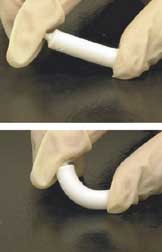
Photo from wikipedia
PCL nanofibrous scaffolds are widely used as bone scaffolds, and they can increase the efficiency of bone regeneration by loading drugs and/or growth factors onto them. However, to obtain a… Click to show full abstract
PCL nanofibrous scaffolds are widely used as bone scaffolds, and they can increase the efficiency of bone regeneration by loading drugs and/or growth factors onto them. However, to obtain a more effective bone regeneration effect, it is necessary to increase drug loading and release efficiency. In this study, conductive hydrogel forming nanofibrous scaffolds were prepared to increase drug efficiency. GO has an excellent conductivity and biocompatibility, making it an efficient conductive polymer for bone differentiation. Electrospun PCL was immersed in a mixed solution of GO and PVP and then crosslinked using gamma-ray irradiation. It was confirmed that GO/PVP-PCL was successfully prepared through its characterization (morphology, thermal, chemical, electrical, and biological properties). In addition, drug-release efficiency was confirmed by electrical stimulation after loading the sample with BMP-2, a bone-regeneration growth factor. Compared to PCL, it was confirmed that GO/PVP-PCL has an approximately 20% improved drug-release efficiency and an excellent mineralization of the scaffolds using SBF. After culturing MG63 cells on GO/PVP-PCL, a high effect on osteodifferentiation was confirmed by ALP activity. Therefore, GO/PVP-PCL prepared by a gamma-ray-induced crosslinking reaction is expected to be used as biomaterial for bone-tissue engineering.
Journal Title: Materials
Year Published: 2022
Link to full text (if available)
Share on Social Media: Sign Up to like & get
recommendations!